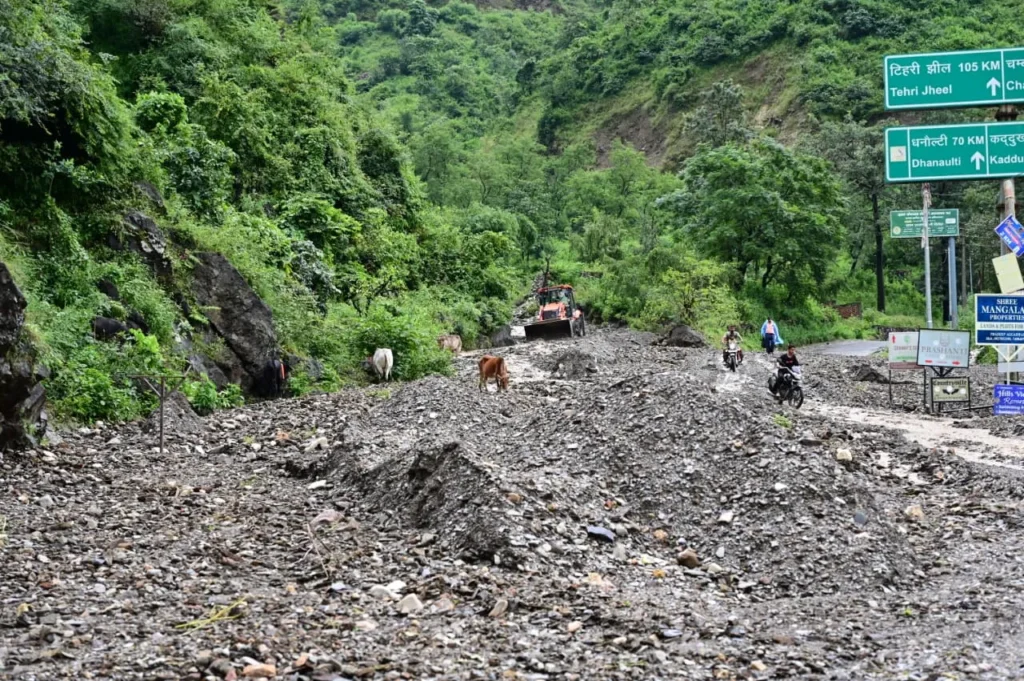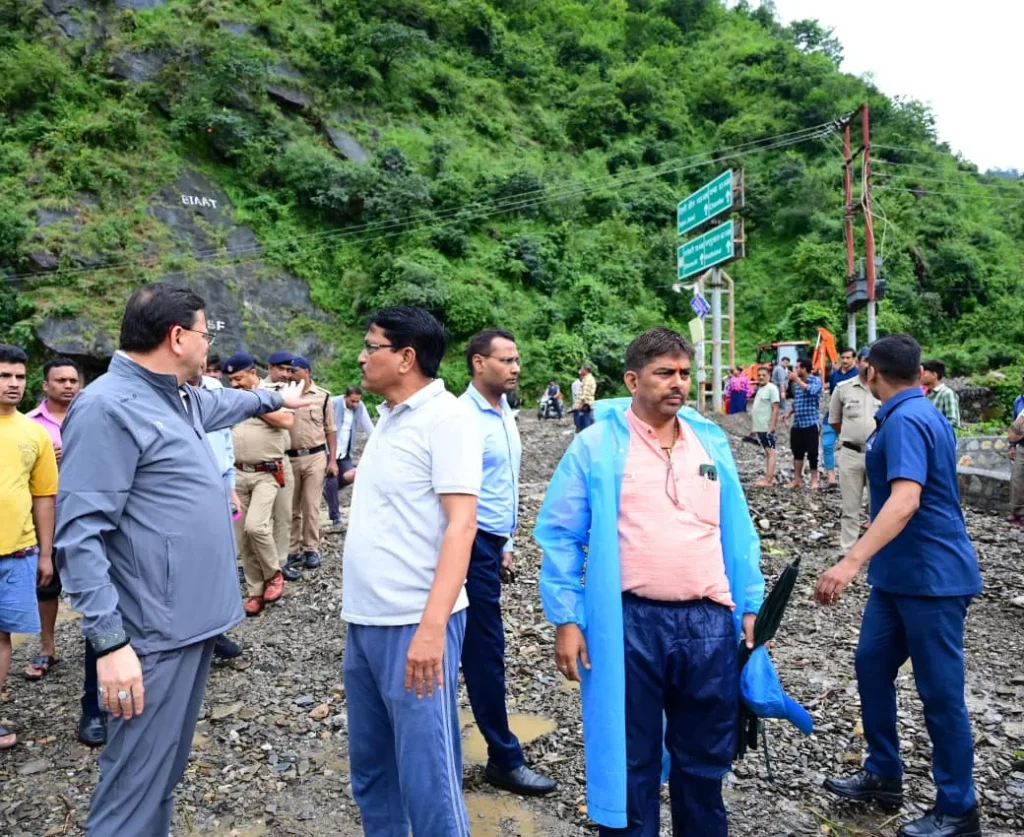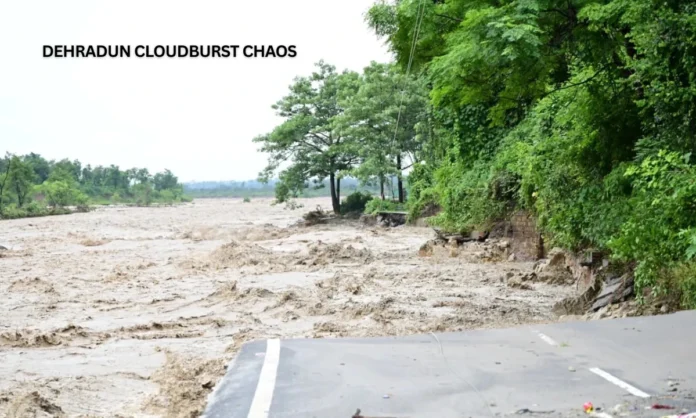Key Highlights:
- Four fatalities confirmed in Dehradun cloudburst with massive destruction to shops, vehicles, and infrastructure across Sahastradhara area
- Over 200 students rescued from flooded institutions as NDRF and SDRF teams deploy emergency operations throughout affected regions
- Uttarakhand records 85 deaths and 94 missing persons since April 2025 in worst monsoon season since Kedarnath disaster
Initial Devastation and Emergency Response
A catastrophic Dehradun cloudburst devastated the hill station in the early hours of Tuesday, September 16, 2025, marking another deadly chapter in Uttarakhand’s worst monsoon crisis in over a decade. The Dehradun cloudburst initially reported two missing persons, but authorities later confirmed four fatalities as rescue operations intensified across the affected Sahastradhara region. Disaster Secretary Vinod Kumar Suman confirmed the casualties following extensive search operations by specialized rescue teams.

The Dehradun cloudburst triggered torrential rainfall that transformed ordinary streets into raging torrents, washing away numerous shops and vehicles while damaging critical infrastructure including bridges and roads. District Magistrate Savin Bansal immediately deployed National Disaster Response Force (NDRF) and State Disaster Response Force (SDRF) teams alongside Public Works Department officials who arrived with heavy machinery to conduct emergency operations. The Dehradun cloudburst devastation extended beyond Sahastradhara to multiple areas including IT Park and Premnagar, where severe waterlogging trapped residents and disrupted normal activities.
Chief Minister Pushkar Singh Dhami maintained constant communication with local administration officials while personally visiting areas affected by the Dehradun cloudburst with cabinet ministers to assess the crisis firsthand. The government immediately ordered closure of all schools from Class 1 to 12 across Dehradun district as a precautionary measure against continued weather threats following the Dehradun cloudburst incident.
LIVE: मालदेवता, देहरादून में अतिवृष्टि से हुए जलभराव एवं भू-कटाव वाले क्षेत्रों का स्थलीय निरीक्षण
— Pushkar Singh Dhami (@pushkardhami) September 16, 2025
https://t.co/UOYuSRNy4M
Rescue Operations and Infrastructure Damage
The Dehradun cloudburst prompted immediate large-scale evacuation efforts across multiple locations. SDRF teams successfully rescued over 200 students trapped by severe waterlogging at Dev Bhoomi Institute Ponda on Dehradun-Vikasnagar road. NDRF personnel conducted a dramatic rescue of an individual stranded on an electricity pole in the swollen Tons river. Three persons trapped in the flooding Chandrabhaga river near Rishikesh were evacuated by specialized rescue teams responding to the broader impact of the Dehradun cloudburst.

The Dehradun cloudburst caused unprecedented infrastructure damage across multiple districts, with the Dehradun-Haridwar National Highway bridge suffering significant structural damage that disrupted regional connectivity. The famous Tapkeshwar Mahadev temple experienced severe flooding as the swollen Tamsa river inundated the temple premises, with water reaching the Hanuman statue although the main sanctum remained protected. Local temple priest Acharya Bipin Joshi reported that river levels began rising dramatically from 5 AM, creating the most severe flooding situation the temple had witnessed in recent years following the Dehradun cloudburst.
Additionally, a massive landslide completely blocked roads in Pithoragarh district, causing extensive traffic disruptions as administration teams worked to restore connectivity. The cumulative impact of these infrastructure failures highlighted the vulnerability of Uttarakhand’s transportation and religious tourism networks to extreme weather events like the Dehradun cloudburst.
Broader Monsoon Crisis Across Uttarakhand
Official statistics reveal the catastrophic scope of Uttarakhand’s 2025 monsoon season, with natural disasters including the recent Dehradun cloudburst claiming 85 lives, injuring 128 people, and leaving 94 missing since April. This represents the state’s worst monsoon crisis since the devastating Kedarnath tragedy of 2013, with estimated damages exceeding Rs 5,000 crore across affected regions. The monsoon season has recorded extreme weather events on 65% of days, a dramatic increase from 33% in 2022, indicating accelerating climate impacts that contribute to incidents like the Dehradun cloudburst.

Multiple districts including Uttarkashi, Chamoli, Rudraprayag, Pauri, Bageshwar, and Nainital have experienced repeated cloudbursts and landslides throughout the season, similar to the recent Dehradun cloudburst. The Dharali area of Uttarkashi district witnessed a particularly devastating cloudburst on August 5, 2025, resulting in multiple casualties and widespread destruction of homes, hotels, and infrastructure. Analysis shows that the second half of monsoon seasons typically records equally severe weather patterns, suggesting continued risks for additional incidents following the Dehradun cloudburst.
Weather data indicates that Uttarakhand received 187.6 mm of rainfall during recent weeks compared to the normal 64.7 mm, representing nearly 300% above average precipitation levels that contributed to conditions causing the Dehradun cloudburst. The India Meteorological Department has maintained red alerts for several districts including Uttarkashi, Rudraprayag, Dehradun, Tehri, and Nainital throughout the current monsoon period.

Uttarakhand Monsoon Crisis 2025: Comprehensive impact assessment showing casualties and economic losses
Government Response and Financial Relief Measures
Prime Minister Narendra Modi announced a comprehensive financial assistance package of Rs 1,200 crore for Uttarakhand’s disaster-affected areas during his September 11, 2025 visit to Dehradun, prior to the recent Dehradun cloudburst incident. The relief package includes Rs 2 lakh compensation for families of deceased victims and Rs 50,000 for seriously injured individuals, along with comprehensive support through the PM CARES for Children scheme for orphaned children. This represents the largest disaster relief announcement for Uttarakhand since the 2013 Kedarnath reconstruction efforts, though additional support may be needed following the Dehradun cloudburst.
The Prime Minister emphasized a multi-dimensional recovery approach encompassing home reconstruction under PM Awas Yojana, national highway restoration, school rebuilding, and livestock relief distribution. Additional assistance will be considered based on recommendations from inter-ministerial teams that recently assessed damage across Uttarkashi, Chamoli, Bageshwar, and Nainital districts, with the Dehradun cloudburst adding to the assessment requirements. The Central government has assured full support for infrastructure restoration and rebuilding efforts in coordination with state authorities.
During his visit, Modi praised the efforts of NDRF, SDRF personnel, and disaster volunteers who provided crucial assistance during emergency operations, capabilities that proved essential during the Dehradun cloudburst response. However, opposition parties criticized the announced financial package as insufficient given the scale of destruction and economic losses estimated at Rs 5,000 crore, a figure that may increase following the Dehradun cloudburst assessment.
Final Perspective
The Dehradun cloudburst represents a devastating culmination of Uttarakhand’s most severe monsoon season in over a decade, highlighting the state’s increasing vulnerability to extreme weather events driven by climate change factors. With 85 confirmed deaths and damages exceeding Rs 5,000 crore, this monsoon crisis surpasses all natural disasters in Uttarakhand since the 2013 Kedarnath tragedy. The successful rescue of over 200 students and multiple emergency evacuations demonstrate the crucial importance of coordinated disaster response capabilities involving NDRF, SDRF, and state agencies during incidents like the Dehradun cloudburst.
धराली (उत्तरकाशी) के आपदा प्रभावित क्षेत्र में फंसे स्थानीय निवासियों के साथ-साथ अन्य राज्यों से आए श्रद्धालुओं को राहत और बचाव दलों द्वारा त्वरित और प्रभावी कार्रवाई करते हुए बड़ी संख्या में सुरक्षित निकाला गया है।
— Pushkar Singh Dhami (@pushkardhami) August 9, 2025
आदरणीय प्रधानमंत्री श्री @narendramodi जी के मार्गदर्शन में… pic.twitter.com/e0P0cv6LmK
As rescue operations continue and infrastructure restoration begins following the Dehradun cloudburst, the scale of destruction across multiple districts underscores the urgent need for enhanced early warning systems and climate-resilient development planning in the Himalayan region. The government’s Rs 1,200 crore relief package, while substantial, must be supplemented with long-term strategies to address the increasing frequency and intensity of extreme weather events affecting Uttarakhand’s vulnerable mountain communities, particularly after incidents like the recent Dehradun cloudburst.


